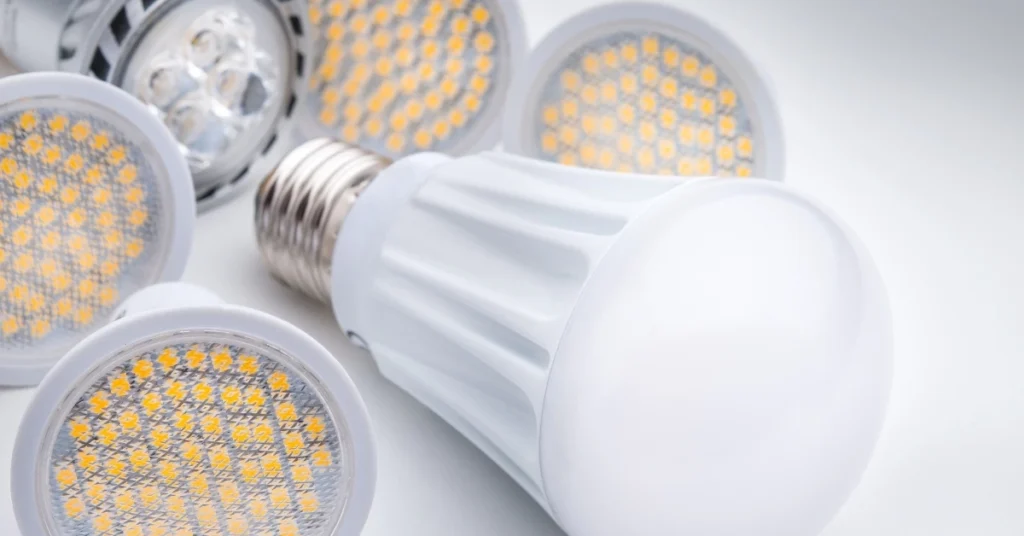目次
トグルはじめに
電球の発明は、人間と環境との関わり方に革命をもたらした。しかし、誰が電球を作ったのか、誰が電球を発明したのか。本当にトーマス・エジソンが発明したのか、それとも他の発明家が功績に値するのか?初期の発明家たちの貢献、時を経て改良された点、そしてレッドリズムのような企業による現代の進歩を探る。
誰が電球を発明したか、作ったか:先駆者たち
電球の発明についてよくある誤解がある:トーマス・エジソンが唯一の発明者である。実際には、電球の発明は多方面にわたる努力の結果であり、エジソンの重要な貢献は実用的な白熱灯の完成と商品化であった。
電球の誕生には、ハンフリー・デイヴィ、ジョセフ・スワン、トーマス・エジソンなど多くの発明家の貢献があった。


1806年に電球を発明した人物
1806年、ハンフリー・デイヴィが初めて電気アーク灯を実演した。これは人類が初めて電気を使って光を発生させたものだが、現代的な意味での電球ではなかった。非常に明るかったが、消費電力が大きく、寿命も短かったため、広く普及することはできなかった。
ウォーレン・ド・ラ・ルー、1840年
真空ガラス管の中に白金線を入れ、電気を流して発光させれば効率は高いが、白金は高価なので実用的ではない。
ジョセフ・スワン(イギリス、1850~1878年
1860年、彼はカーボンフィラメントの白熱灯のプロトタイプを作ったが、真空技術が未熟だったため、フィラメントは急速に酸化してしまった。
1878年(エジソンより1年早い)、改良された真空技術を用いたカーボンフィラメント電球を公開。イギリスで特許を取得し、小規模な設置を開始した。
エジソンの躍進(1879年)
炭素フィラメントと真空封入ガラス電球を使用し、業務用および家庭用の長寿命で低コストの白熱電球を発明した。
1879年10月22日:彼のチームは、炭素フィラメント電球で14.5時間の連続点灯に成功。彼は、発電機、配線、スイッチ、ヒューズなどの完全な電力供給システムを設計し、電気照明を大規模に使用できるようにした。
電球を発明した人だ。
彼が最初に電球を作ったわけではないが、彼のデザインは安定していて製造可能であり、家庭での使用に適していた。エジソンの功績は広く知られているが、実は電球の発明は数十年にわたる共同作業だった。

電球クリエーター
その旅は19世紀初頭、デイヴィのアーク灯から始まった。エジソンは1879年に特許を取得したが、誰が最初の電球を発明したのかという疑問は、いまだに論争が続いている。
電球の発明者
| クリエイター | 年 | 貢献 |
|---|---|---|
| ハンフリー・デイヴィ | 1806 | 電気アーク灯 |
| ジョセフ・スワン | 1850-1878 | 初期のカーボンフィラメント電球 |
| トーマス・エジソン | 1879 | 実用的な白熱電球 |
最初の電球とその進化
ハンフリー・デイヴィがアーク灯を発明。明るかったが、かさばり、損失が大きく、家庭用には適さなかった。真の電球ではなかったのだ。
| 年 | 発明・改良 | 主な特徴 |
|---|---|---|
| 1806 | アークランプ(ハンフリー・デイヴィ) | カーボンアークを使った最初の電灯。 |
| 1841 | プラチナフィラメント電球(ウォーレン・ドゥ・ラ・リュー) | プラチナワイヤー付き真空ガラスバルブ。 |
| 1854 | 初期のカーボンフィラメント電球(ハインリッヒ・ゲーベル) | 炭化竹フィラメントの早期使用を主張。 |
| 1878-1879 | 実用白熱電球(ジョセフ・スワン&トーマス・エジソン) | カーボンフィラメントを使用した真空封止電球。 |
| 1906+ | タングステンフィラメント電球 | より高い効率性と耐久性、数十年にわたり一般家庭で標準的に使用されている |
| 20世紀後半 | コンパクト蛍光灯&LED電球 | 省エネ、長寿命、白熱電球から徐々に置き換え |
電球を発明したのは誰なのか?
誰が電球を発明したかをめぐる論争は今日まで続いている。電球は一個人によって発明されたのではなく、数十年にわたる一連の科学者によって発明されたのである。論争の核心は「発明」の定義にある。誰が最初にコンセプトを思いついたのか、誰が最初に実用的な装置を設計したのか、誰が最初に商品化したのか。
エジソンはその設計を商品化した能力で最も認知されているが、デイヴィやスワンらの貢献も無視できない。
電球の特許を取ったのは誰?
ジョセフ・スワンとトーマス・エジソンは、ほぼ同時に実用的な白熱電球を発明した。スワンはエジソンを特許侵害で英国に提訴。両社は最終的に和解し、1883年に合併して "エジソン&スワン社 "を設立した。
エジソンの最終的な設計最適化には以下が含まれる:
- 炭化フィラメントの使用
- 真空レベルを上げる
- 安定した電流システム(発電+配電+照明)の提供
1879年10月、エジソンは40時間以上持続する電球の点灯に成功し、特許を申請した。
トーマス・エジソンによる電球の改良とは?
- プラチナ、竹、綿糸など1,600以上の素材をテストした後、最終的に炭化綿フィラメントに落ち着いた(1879年)。
- 彼らは高真空ガラス電球を開発し、ガラス職人と協力してその寿命を大幅に延ばした。
- 1879年10月22日炭素フィラメント電球で14.5時間の連続点灯に成功。
- 彼らは発電機、配線、スイッチ、ヒューズなど、完全な電力供給システムを設計し、電気照明の普及を可能にした。
最終的な感想
電球は一人の人間によって一夜にして発明されたものではなく、複数の発明家による1世紀近くにわたる絶え間ない改良の賜物である。トーマス・エジソンは、電球を商品化し実用化した立役者として広く知られており、その後のタングステンフィラメント電球は、まさに照明の時代を切り開いた。
デイヴィの実験からエジソンの発見、そしてレッドリズムによる現代の革新まで、電球の歴史は人類のたゆまぬ進歩への探求を示している。
人々はこうも尋ねる
電球の特許は誰の手に?
ジョセフ・スワンやトーマス・エジソンなど、歴史上多くの電球発明者が特許を取得している。
| 発明者 | 国名 | 特許番号/年 | テクニカル・フォーカス | 法的地位 |
|---|---|---|---|---|
| ジョセフ・スワン | イギリス | 1860, 1878 | 真空カーボンフィラメント電球 | 英国市場をリードし、後にエジソンと合併。 |
| エジソン | 米国 | 223,898 (1880) | 実用的なカーボンフィラメント+電源システム | 6年間の訴訟の末、米国で特許成立。 |
| ソーヤー&マン | 米国 | 205,144 (1878) | 炭素棒電球 | エジソンの特許でカバー |
| ウッドワード | カナダ | 3,738 (1874) | 窒素封入カーボン棒電球 | 特許をエジソンに売却 |
電球を最初に発明したのは?
電球を最初に発明したのはハンフリー・デイヴィーである。1806年、彼はガス放電によって光を発生させる原理を応用したアーク灯を発明した。これが電球開発の基礎を築いた。
電球の発明はいつ?
- 1806年、ハンフリー・デイヴィが電気アーク灯を発明した。
- 1879年、トーマス・エジソンは白熱電球を発明した。
この2つが大きな転機となった。
エジソンは電球の創始者?
誰が電球を発明したかについては、いまだに議論がある。
ハンフリー・デイヴィが初期のプロトタイプを実演したので、エジソンは電球の発明者とはみなされない。また、ジョセフ・スワンが同時期に白熱電球を発明しているため、エジソンを白熱電球の発明者とみなすこともできない。
電球を設計したのは誰?
電球の実用的な設計は、ジョセフ・スワンとトーマス・エジソンが共同で開発した。
スワンは1878年に真空カーボンフィラメント電球を開発し、英国特許を取得。1879年、エジソンがフィラメント素材を最適化し、電源システムを開発したことで、大規模な商業化が可能になった。最終的に、両社は世界的な普及を促進するために特許を統合した。








